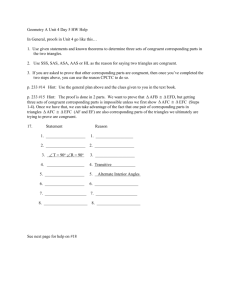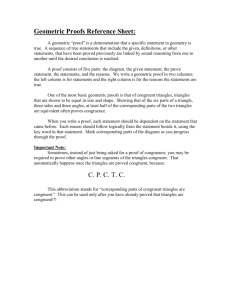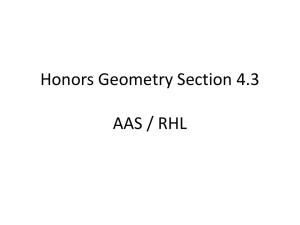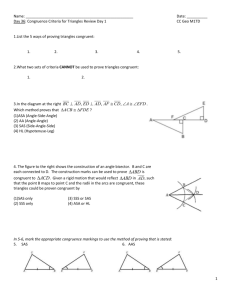Overview - Connecticut Core Standards
advertisement
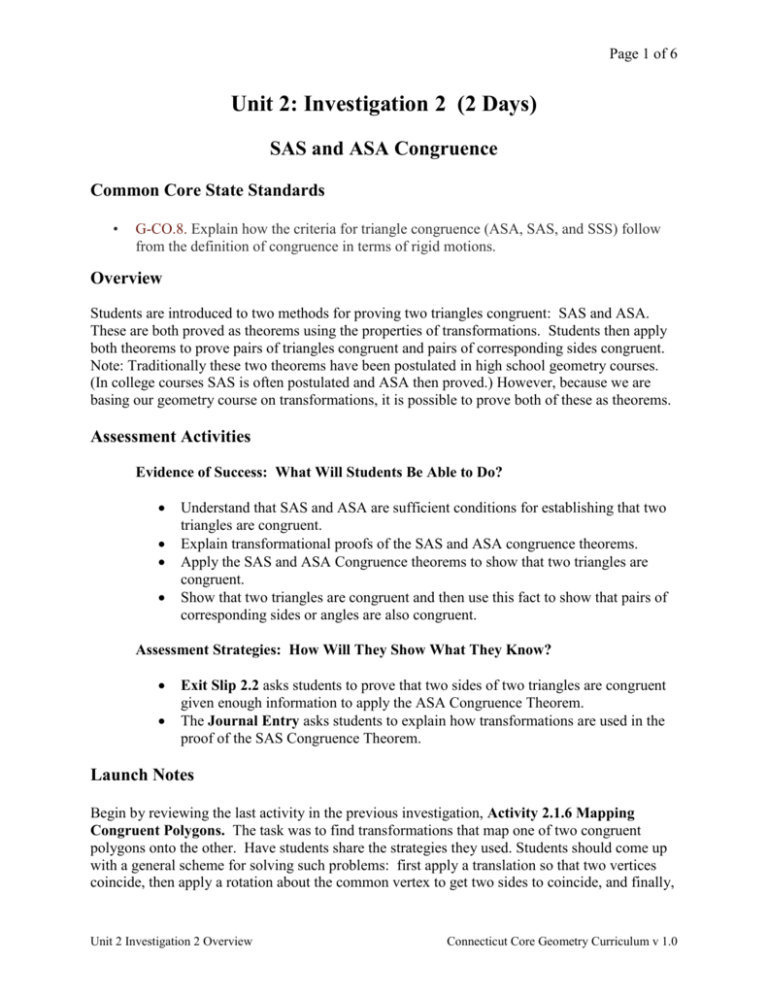
Page 1 of 6 Unit 2: Investigation 2 (2 Days) SAS and ASA Congruence Common Core State Standards • G-CO.8. Explain how the criteria for triangle congruence (ASA, SAS, and SSS) follow from the definition of congruence in terms of rigid motions. Overview Students are introduced to two methods for proving two triangles congruent: SAS and ASA. These are both proved as theorems using the properties of transformations. Students then apply both theorems to prove pairs of triangles congruent and pairs of corresponding sides congruent. Note: Traditionally these two theorems have been postulated in high school geometry courses. (In college courses SAS is often postulated and ASA then proved.) However, because we are basing our geometry course on transformations, it is possible to prove both of these as theorems. Assessment Activities Evidence of Success: What Will Students Be Able to Do? Understand that SAS and ASA are sufficient conditions for establishing that two triangles are congruent. Explain transformational proofs of the SAS and ASA congruence theorems. Apply the SAS and ASA Congruence theorems to show that two triangles are congruent. Show that two triangles are congruent and then use this fact to show that pairs of corresponding sides or angles are also congruent. Assessment Strategies: How Will They Show What They Know? Exit Slip 2.2 asks students to prove that two sides of two triangles are congruent given enough information to apply the ASA Congruence Theorem. The Journal Entry asks students to explain how transformations are used in the proof of the SAS Congruence Theorem. Launch Notes Begin by reviewing the last activity in the previous investigation, Activity 2.1.6 Mapping Congruent Polygons. The task was to find transformations that map one of two congruent polygons onto the other. Have students share the strategies they used. Students should come up with a general scheme for solving such problems: first apply a translation so that two vertices coincide, then apply a rotation about the common vertex to get two sides to coincide, and finally, Unit 2 Investigation 2 Overview Connecticut Core Geometry Curriculum v 1.0 Page 2 of 6 if necessary, reflect about the common side to get the third pair of vertices to coincide. This is the strategy that will be used in the proofs of the SAS and ASA congruence theorems. Teaching Strategies In Activity 2.2.1 SAS Congruence students first perform an experiment that leads to a conjecture that if two sides and the included angle of one triangle are congruent to two sides and the included angle of another triangle (SAS) then the triangles are congruent. You may want to stop at this point to make sure that students understand the conjecture, which will become a theorem. The conjecture is in the form of a conditional (if-then) statement. The “if” part (the hypothesis) is often abbreviated “SAS.” The “then” part (the conclusion) is that the two triangles are congruent. In writing the congruence statement for a specific pair of triangles be sure that corresponding vertices are in the same order. Activity 2.2.1 then walks students through a transformational proof of the theorem. See the appendix for the proof. You may want to do this as a teacher-led whole class activity. Before starting the proof you will need to introduce (or review) two new postulates. The PointLine Postulate states that between two points it is possible to construct exactly one line and that two lines intersect in at most one point. The Plane Separation Postulate allows us to describe points not on a line as lying on one side or the other of the line. Both of these postulates are used in the proofs of the SAS and ASA congruence theorems. You can then follow with individual or group work on Activity 2.2.2 Applying the SAS Congruence Theorem. This activity gives students practice writing short proofs. In the first set of exercises students use SAS to prove that two triangles are congruent. In the second set they must prove that two triangles are congruent and then show that a pair of corresponding parts are also congruent. In the third students will be asked whether or not a pair of triangles can be proved congruent. Several examples will include the SSA pattern, which, of course, is not sufficient to establish congruence. Note: We often use SAS as a shorthand abbreviation for the theorem. However we should emphasize the name of the theorem: SAS Congruence Theorem because in Unit 4 we will encounter the SAS Similarity Theorem. The same consideration applies to ASA and SSS. Differentiated Instruction (For Learners Needing More Help) Make sure that students understand what is meant my “included” side and “included” angle before introducing proofs of the theorems. Homework for the first day might include finishing Activity 2.2.2. You may also want to assign the Journal prompt at this time. Journal Entry Explain how transformations are used in the proof of the SAS Congruence Theorem. Look for students to explain how they are used to show that the image one triangle may be made to coincide with the other triangle. Unit 2 Investigation 2 Overview Connecticut Core Geometry Curriculum v 1.0 Page 3 of 6 Activity 2.2.3 ASA Congruence walks students through a transformational proof of the theorem. See the appendix for the proof. Because this proof is very similar to the proof of SAS, you may want students to work in groups to complete the activity before going over it with the entire class. Then follow this up with Activity 2.2.4 Applying SAS and ASA Congruence Theorems. This activity is very similar to Activity 2.2.2, only now we have two ways to prove that triangles are congruent. At the end of the second day you may give students Exit Slip 2.2 in which they write a short proof using ASA. Group Activity Activity 2.2.5 Posing Problems with Congruent Triangles is designed for students to work in groups of four. The first student picks a theorem (SAS or ASA). The second student makes up a problem requiring a proof using the theorem. The third student writes the proof. The fourth student checks the proof. Then rotate the roles so that everyone plays each role Differentiated Instruction (Enrichment) Have students discover and then prove the SASAS criterion for two quadrilaterals to be congruent. A proof may be based on transformations or by drawing a diagonal and applying SAS to both triangles. Closure Notes Give students two minutes to complete one of questions (4-7) Activity 2.2.6 Which Triangles Can Be Proved Congruent? Five triangles are given. For the first, the measures of all 6 parts are known. The other four have given measurement that match the first in one of the patterns SAS, SSA, ASA, and AAS. Students are asked to identify the two triangles that can be proved congruent to the first one using only the two congruence theorems they have learned. Once they have made their choices, poll the class to check for understanding. The remaining questions from this activity could be assigned for homework. Vocabulary Included side Included angle Hypothesis Conclusion Theorems and Postulates Point-Line Postulate. Between two points it is possible to construct exactly one line. Two lines intersect in at most one point. Unit 2 Investigation 2 Overview Connecticut Core Geometry Curriculum v 1.0 Page 4 of 6 Plane Separation Postulate: If a line l lies in a plane then every point in the plane not on l lies on one side or the other side of l. If B lies on the opposite side of l from A then line AB intersects line l in one point. SAS Congruence Theorem: If two sides and the included angle of one triangle are congruent to two sides and the included angle of a second triangle, then the two triangles are congruent to each other. ASA Congruence Theorem: If two angles and the included side of one triangle are congruent to two angles and the included side of a second triangle, then the two triangles are congruent to each other. Resources and Materials Activity 2.2.1 SAS Congruence Activity 2.2.2 Applying the SAS Congruence Theorem Activity 2.2.3 ASA Congruence Activity 2.2.4 Applying SAS and ASA Congruence Theorems Activity 2.2.5 Posing Problems with Congruent Triangles Activity 2.2.6 Which Triangles Can Be Proved Congruent? Unit 2 Investigation 2 Overview Connecticut Core Geometry Curriculum v 1.0 Page 5 of 6 Appendix: Transformational Proofs of Some Theorems SAS Congruence Given ∆ABC and ∆DEF with AB = DE, AC = DF, and m∠BAC = m∠EDF Prove ∆ABC ≅ ∆DEF. 1. If A and D do not coincide then translate ∆DEF by the vector from D to A. 2. If AB and D’E’ do not coincide then rotate ∆D’E’F’ about point A(D’) through ∠E’AB 3. D’’E’’ will now coincide with AB since we were given that AB = DE. 4. If F’’ is on the opposite side of AB from C, reflect ∆D’’E’’F’’ over line AB. 5. ∠E’’’D’’’F’’’ will now coincide with ∠BAC since we were given m∠BAC = m∠EDF, and D’’’F’’’ will coincide with AC since we were given AC = DF. 6. Therefore F’’’ coincides with C and E’’’ coincides with B. Since exactly one line may be drawn through two points (Postulate 1) we conclude that E’’’F’’’ coincides with BC. 7. Since ∆ABC is the image of ∆DEF under an isometry, ∆ABC ≅ ∆DEF. Unit 2 Investigation 2 Overview Connecticut Core Geometry Curriculum v 1.0 Page 6 of 6 ASA Congruence Given ∆ABC and ∆DEF with AB = DE, m∠BAC = m∠EDF, and m∠ABC = m∠EDF Prove ∆ABC ≅ ∆DEF. Steps 1-4 are identical with those in the proof of the SAS Congruence Theorem. 5. ∠E’’’D’’’F’’’ will now coincide with ∠BAC since we were given m∠BAC = m∠EDF, and ∠D’’’E’’’F’’’ will now coincide with ∠ABC since we were given m∠ABC = m∠DEF. 6. Therefore ray D’’’F’’’ coincides with ray AC and ray E’’’F’’’ coincides with ray BC. Since two lines may intersect in at most one point (Postulate 1) we conclude that point F’’’ coincides with point C. 7. Since ∆ABC is the image of ∆DEF under an isometry, ∆ABC ≅ ∆DEF. Unit 2 Investigation 2 Overview Connecticut Core Geometry Curriculum v 1.0

